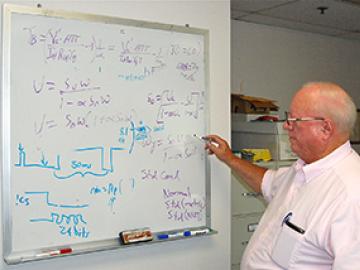Filter News
Area of Research
- (-) Computational Engineering (3)
- (-) Fossil Energy (1)
- (-) Sensors and Controls (4)
- Advanced Manufacturing (20)
- Biological Systems (3)
- Biology and Environment (134)
- Biology and Soft Matter (4)
- Building Technologies (9)
- Chemical and Engineering Materials (4)
- Chemistry and Physics at Interfaces (7)
- Clean Energy (320)
- Climate and Environmental Systems (11)
- Computational Biology (2)
- Computational Chemistry (5)
- Computer Science (13)
- Data (1)
- Earth Sciences (1)
- Electricity and Smart Grid (2)
- Energy Frontier Research Centers (7)
- Energy Sciences (2)
- Fuel Cycle Science and Technology (2)
- Functional Materials for Energy (8)
- Fusion and Fission (36)
- Fusion Energy (15)
- Geographic Information Science and Technology (1)
- Isotope Development and Production (1)
- Isotopes (26)
- Materials (197)
- Materials for Computing (23)
- Materials Synthesis from Atoms to Systems (8)
- Materials Under Extremes (7)
- Mathematics (1)
- National Security (53)
- Neutron Data Analysis and Visualization (4)
- Neutron Science (107)
- Nuclear Science and Technology (45)
- Nuclear Systems Modeling, Simulation and Validation (2)
- Quantum Condensed Matter (3)
- Quantum information Science (7)
- Renewable Energy (4)
- Supercomputing (194)
- Transportation Systems (6)
Media Contacts

Researchers at Oak Ridge National Laboratory have identified a statistical relationship between the growth of cities and the spread of paved surfaces like roads and sidewalks. These impervious surfaces impede the flow of water into the ground, affecting the water cycle and, by extension, the climate.

A method developed at Oak Ridge National Laboratory to print high-fidelity, passive sensors for energy applications can reduce the cost of monitoring critical power grid assets.

A study led by Oak Ridge National Laboratory explored the interface between the Department of Veterans Affairs’ healthcare data system and the data itself to detect the likelihood of errors and designed an auto-surveillance tool

Philip Bingham has two pieces of advice for researchers new to Oak Ridge National Laboratory: (1) develop a skill set that can be applied to multiple research areas, and (2) get out and meet folks across the lab. “The favorite part of my work is that I’ve done a lot of very diffe...








